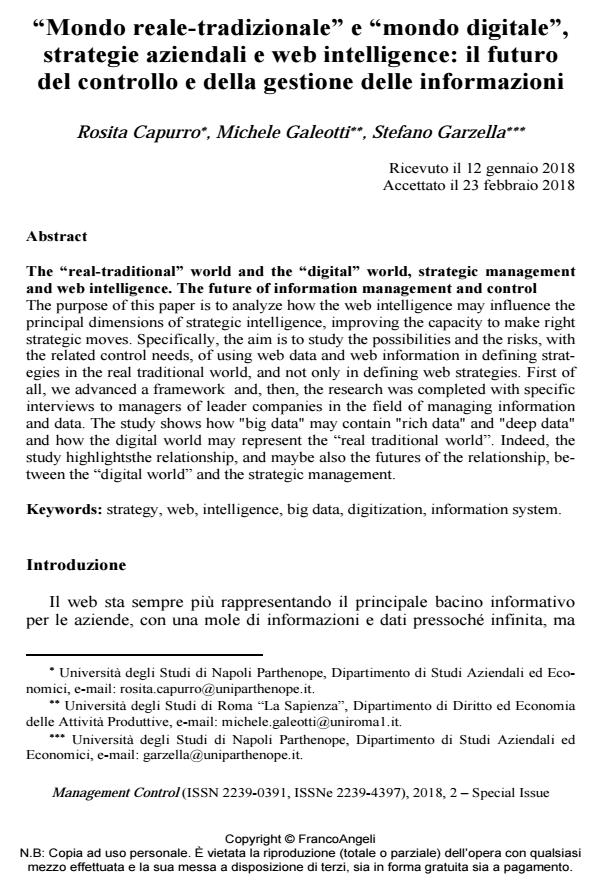The "real-traditional" world and the "digital" world, strategic management and web intelligence. The future of information management and control
Journal title MANAGEMENT CONTROL
Author/s Rosita Capurro, Michele Galeotti, Stefano Garzella
Publishing Year 2018 Issue 2018/2 Suppl.
Language Italian Pages 29 P. 83-111 File size 444 KB
DOI 10.3280/MACO2018-SU2005
DOI is like a bar code for intellectual property: to have more infomation
click here
Below, you can see the article first page
If you want to buy this article in PDF format, you can do it, following the instructions to buy download credits

FrancoAngeli is member of Publishers International Linking Association, Inc (PILA), a not-for-profit association which run the CrossRef service enabling links to and from online scholarly content.
The purpose of this paper is to analyze how the web intelligence may influence the principal dimensions of strategic intelligence, improving the capacity to make right strategic moves. Specifically, the aim is to study the possibilities and the risks, with the related control needs, of using web data and web information in defining strat-egies in the real traditional world, and not only in defining web strategies. First of all, we advanced a framework and, then, the research was completed with specific interviews to managers of leader companies in the field of managing information and data. The study shows how "big data" may contain "rich data" and "deep data" and how the digital world may represent the "real traditional world". Indeed, the study highlightsthe relationship, and maybe also the futures of the relationship, between the "digital world" and the strategic management.
Keywords: Strategy, web, intelligence, big data, digitization, information system
- Gestione integrata dei dati e performance aziendali Antonella Paolini, in MANAGEMENT CONTROL 2/2022 pp.5
DOI: 10.3280/MACO2022-002001 - Management Control System in Smart and Sustainable Firms Domenica Lavorato, pp.137 (ISBN:978-3-031-81435-8)
- La Business Intelligence e la Business Analytics nell'era dei Big Data: una analisi della letteratura Arianna Petrosino, Daniela Mancini, Stefano Garzella, Rita Lamboglia, in MANAGEMENT CONTROL 3/2018 pp.31
DOI: 10.3280/MACO2018-003003 - Integrated reporting o disintegrated reporting? Un'analisi teorica per una proposta empirica di reale integrazione Paolo Esposito, Stefano Garzella, Domenica Lavorato, in MANAGEMENT CONTROL 3/2024 pp.87
DOI: 10.3280/MACO2024-003005 - Management Control System in Smart and Sustainable Firms Domenica Lavorato, pp.1 (ISBN:978-3-031-81435-8)
Rosita Capurro, Michele Galeotti, Stefano Garzella, "Mondo reale-tradizionale" e "mondo digitale", strategie aziendali e web intelligence: il futuro del controllo e della gestione delle informazioni in "MANAGEMENT CONTROL" 2 Suppl./2018, pp 83-111, DOI: 10.3280/MACO2018-SU2005